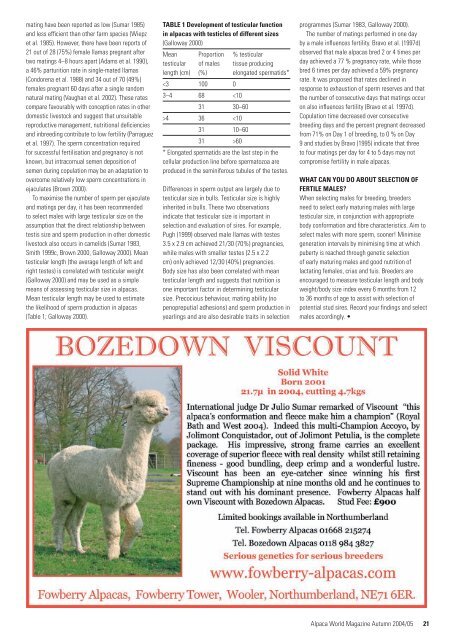Create successful ePaper yourself
Turn your PDF publications into a flip-book with our unique Google optimized e-Paper software.
mating have been reported as low (Sumar 1985)<br />
and less effi cient than other farm species (Wiepz<br />
et al. 1985). However, there have been reports of<br />
21 out of 28 (75%) female llamas pregnant after<br />
two matings 4–8 hours apart (Adams et al. 1990),<br />
a 46% parturition rate in single-mated llamas<br />
(Condorena et al. 1988) and 34 out of 70 (49%)<br />
females pregnant 60 days after a single random<br />
natural mating (Vaughan et al. 2002). These rates<br />
compare favourably with conception rates in other<br />
domestic livestock and suggest that unsuitable<br />
reproductive management, nutritional defi ciencies<br />
and inbreeding contribute to low fertility (Parraguez<br />
et al. 1997). The sperm concentration required<br />
for successful fertilisation and pregnancy is not<br />
known, but intracornual semen deposition of<br />
semen during copulation may be an adaptation to<br />
overcome relatively low sperm concentrations in<br />
ejaculates (Brown 2000).<br />
To maximise the number of sperm per ejaculate<br />
and matings per day, it has been recommended<br />
to select males with large testicular size on the<br />
assumption that the direct relationship between<br />
testis size and sperm production in other domestic<br />
livestock also occurs in camelids (Sumar 1983,<br />
Smith 1999c, Brown 2000, Galloway 2000). Mean<br />
testicular length (the average length of left and<br />
right testes) is correlated with testicular weight<br />
(Galloway 2000) and may be used as a simple<br />
means of assessing testicular size in alpacas.<br />
Mean testicular length may be used to estimate<br />
the likelihood of sperm production in alpacas<br />
(Table 1; Galloway 2000).<br />
TABLE 1 Development of testicular function<br />
in alpacas with testicles of different sizes<br />
(Galloway 2000)<br />
Mean Proportion % testicular<br />
testicular of males tissue producing<br />
length (cm) (%) elongated spermatids*<br />







